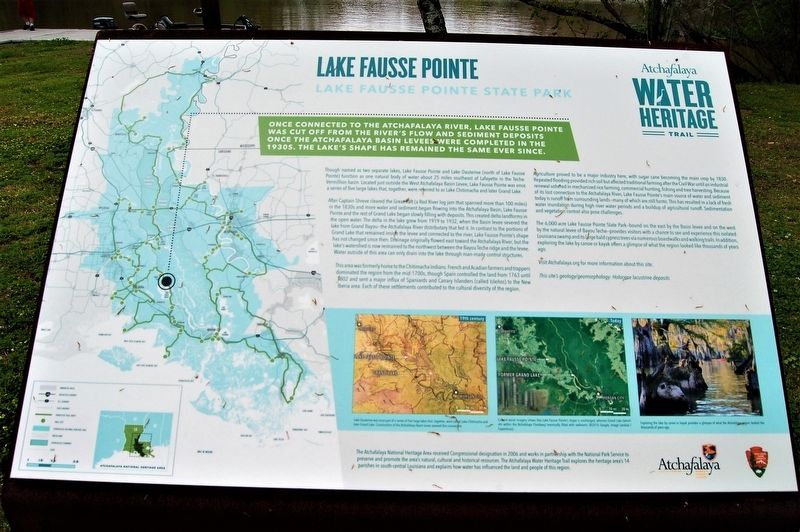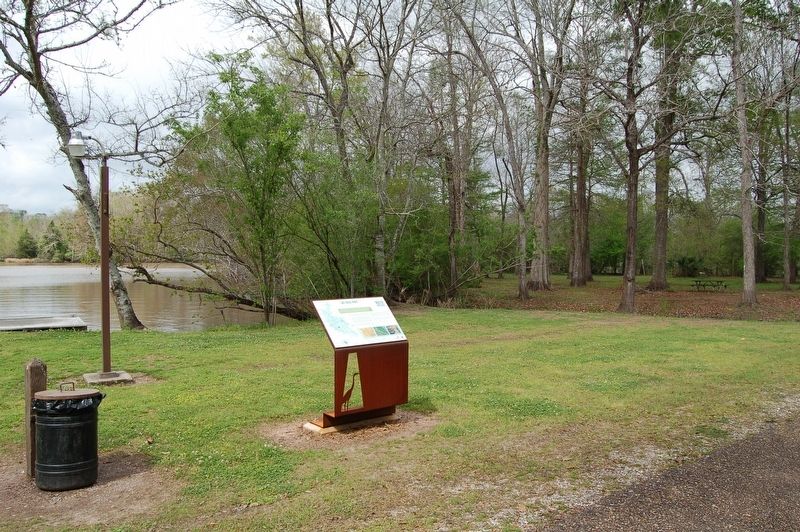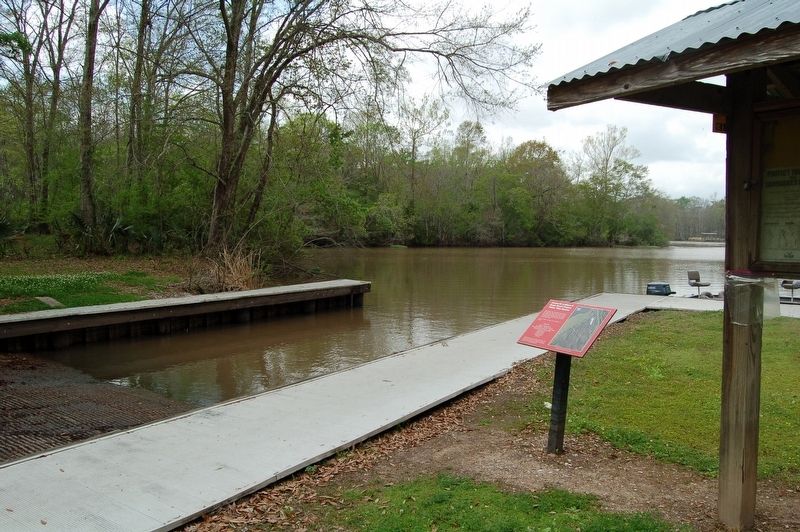Lake Fausse Pointe
Lake Fausse Pointe State Park
— Atchafalaya Water Heritage Trail —
Once connected to the Atchafalaya River, Lake Fausse Pointe was cut off from the river's flow and sediment deposits once the Atchafalaya Basin levees were completed in the 1930s. The lake's shape has remained the same ever since.
Though named as two separate lakes, Lake Fausse Pointe and Lake Dauterive (north of Lake Fausse Pointe) function as one natural body of water about 25 miles southeast of Lafayette in the Teche-Vermillion basin. Located just outside the West Atchafalaya Basin Levee, Lake Fausse Pointe was once a series of five large lakes that, together, were referred to as Lake Chitimacha and later Grand Lake.
After Captain Shreve cleared the Great Raft (a Red River log jam that spanned more than 100 miles) in the 1830s and more water and sediment began flowing into the Atchafalaya Basin, Lake Fausse Pointe and the rest of Grand Lake began slowly filling with deposits. This created delta landforms in the open water. The delta in the lake grew from 1919 to 1932, when the Basin levee severed the lake from Grand Bayou—the Atchafalaya River distributary that fed it. In contrast to the portions of Grand Lake that remained inside the levee and connected to the river, Lake Fausse Pointe’s shape has not changed since then. Drainage originally flowed east toward the Atchafalaya River, but the lake’s watershed
is now restrained to the northwest between the Bayou Teche ridge and the levee. Water outside of this area can only drain into the lake through man-made control structures.This area was formerly home to the Chitimacha Indians. French and Acadian farmers and trappers dominated the region from the mid-1700s, though Spain controlled the land from 1763 until 1802 and sent a major influx of Spaniards and Canary Islanders (called Isleños) to the New Iberia area. Each of these settlements contributed to the cultural diversity of the region.
Agriculture proved to be a major industry here, with sugar cane becoming the main crop by 1830. Repeated flooding provided rich soil but affected traditional farming after the Civil War until an industrial renewal ushered in mechanized rice farming, commercial hunting, fishing and tree harvesting. Because of its lost connection to the Atchafalaya River, Lake Fausse Pointe’s main source of water and sediment today is runoff from surrounding lands—many of which are still farms. This has resulted in a lack of fresh water inundation during high river water periods and a buildup of agricultural runoff. Sedimentation and vegetation control also pose challenges.
The 6,000-acre Lake Fausse Pointe State Park—bound on the east by the Basin levee and on the west by the natural levee of Bayou Teche—provides visitors with a
chance to see and experience this isolated Louisiana swamp and its large bald cypress trees via numerous boardwalks and walking trails. In addition, exploring the lake by canoe or kayak offers a glimpse of what the region looked like thousands of years ago.Visit Atchafalaya.org for more information about this site.
This site’s geology/geomorphology: Holocene lacustrine deposits.
Erected by State of Louisiana and National Park Service.
Topics and series. This historical marker is listed in these topic lists: Environment • Waterways & Vessels. In addition, it is included in the Atchafalaya Water Heritage Trail series list.
Location. 30° 3.714′ N, 91° 36.607′ W. Marker is in St. Martinville, Louisiana, in St. Martin Parish. Marker is on Levee Road (Parish Road 163) 8 miles south of Bayou Alexander Highway (State Highway 3083). Touch for map. Marker is at or near this postal address: 5400 Levee Road, Saint Martinville LA 70582, United States of America. Touch for directions.
Other nearby markers. At least 8 other markers are within 10 miles of this marker, measured as the crow flies. Alligators! (approx. 0.2 miles away); Lake Dauterive (approx. 2.9 miles away); Loreauville Memorial (approx. 7.7 miles away); New Acadia / Nouvelle Acadie (approx. 7.8 miles
More about this marker. Marker is located inside the State Park. Admission fee may be charged. Located at the park's boat ramp.
Credits. This page was last revised on March 12, 2022. It was originally submitted on March 28, 2018, by Cajun Scrambler of Assumption, Louisiana. This page has been viewed 399 times since then and 50 times this year. Photos: 1, 2. submitted on March 28, 2018, by Cajun Scrambler of Assumption, Louisiana. 3. submitted on March 28, 2018.


